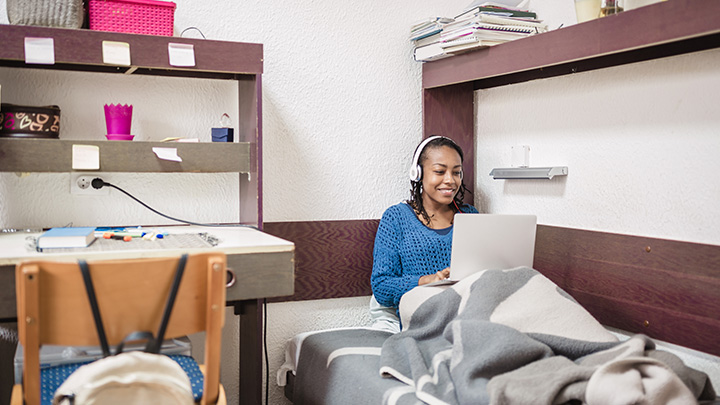Federal data showed that pre-COVID-19 one-third of all enrolled college students took at least one online class. The rate during COVID-19 has skyrocketed, with official numbers yet to be released. While it’s impossible to understate the value of online learning during the pandemic, for small and midsized schools whose pedagogy is centered around intimate, highly collaborative in-person engagement, online learning is bemoaned by faculty. Many hoped that the pandemic might help professors see more value in online learning, but a new survey conducted last month found that the proportion of higher ed instructors who see online learning as effective is only at 49 percent. The good news: that’s up from 39 percent in a similar survey in May after emergency remote learning was implemented.
It’s too easy to accept that online learning is ineffective or will always produce poor levels of engagement. It’s imperative that we think of ways to innovate and improve online learning and extract the greatest value from its contribution to blended learning. This Inside Higher Ed article goes deep into what faculty members see as their biggest objectives to improve the online teaching and learning experience. I’d like to take a look at this as the mother of a college freshman and from the managed services provider’s perspective.
Your residential network is more important than ever
The conversation around student engagement and effective online learning (i.e., ROI) is very personal to me, as my daughter is a first-year student at a state public school here in Texas. When she and I talk about how things are going, my interest always extends beyond my maternal instincts of ensuring that she’s succeeding and taking care of herself. Because of my role at Apogee, I’ve been interested in what tools, platforms, or teaching styles she finds are most effective or engaging.
I’ve learned a lot. First about the ways that my daughter has adapted to make online learning work best for her. She may participate in class from her dorm room. Another time or day she might group together with other students in the residence hall “living room” to stream the class together on a big screen (socially distanced, of course). Or she might find a comfortable place outside or in the library where campus Wi-Fi is still reliable and Zoom her class from there.
But most of the time she attends online class from her dorm room, which shines light on a point that IT and housing leaders may be slow to recognize or accept: your residence hall is the classroom. Let me say that one more time for the people in the back: for now, and foreseeable future, if you accept the premise that blended learning is here to say (it is), the dorm room is also the classroom.
So, what does that mean exactly?
Pre-pandemic, residence hall Wi-Fi played an important role in attracting and retaining students. The near daily technology advances, emerging streaming services, and increasing multitude of personal devices a typical student brings to campus did and still do make it difficult for an institution’s network to stay out in front.
Now consider the implications of ensuring reliable and consistent Wi-Fi to support synchronous learning in your residence hall. Your residential network contribution to enrollment is no longer just about enhancing the on-campus experience (though this is still incredibly important), but about delivering the infrastructure that quite literally decides whether students can participate and learn.
Where once a temporary connectivity drop was an annoyance and student satisfaction issue, a sudden drop of connectivity during online learning is far more damaging: students cut off, faculty members spending unnecessary time and energy to resolve the academic fallout. These are just two examples of serious problems that can and will occur.
Collaboration is the key to online learning innovation
I often speak to a friend whose daughter is also a first-year university student. Faculty members at the daughter’s small, Texas-based private school are beginning to find ways to better teach and engage their online students.
One professor uses Google Jamboard, essentially a digital white board that allows students in a traditional classroom setting to collaborate with other students online from remote locations and vice versa. Another faculty member is using The Meeting Owl – a 360° camera that captures real-time video and audio in a meeting or educational setting and shares it with those online – to better merge traditional and online learning environments and improve engagement.
These are small, incremental improvements but they suggest that the quality of online education and engagement is not inert. There is obvious passion for faculty members to improve the online experience (the Inside Higher Ed article puts data behind this statement). The extent to which IT leaders collaborate and brainstorm along with faculty members to make online learning better will decide just how much progress can be made.
What’s next for your residential network?
Improving your residential network’s reliability and performance while brainstorming other ways to enhance the residence hall learning experience is mission-critical. Much like faculty and IT staffs must work together to improve online learning, IT and residence hall leaders must collaborate to do the same.
A few important questions help frame that conversation:
- What’s missing from the online experience, and how might we bridge the gap?
- What emerging technology solutions, providers, or platforms might help us achieve our goals?
- What are the implications for residential Wi-Fi infrastructure?
- What are the services we might need to outsource to deliver on our infrastructure and experience goals to focus on innovation and the student experience?
In the next blog, we’ll dig in more deeply to the concept of blended learning, revisit some of the ways small and midsized schools can use blended learning to provide differentiated value, and share ideas for getting started. Examining these ideas through the lens of an increasingly important residence hall and ResNet experience will clarify the concrete the steps that can be taken now as your long-term blended learning strategy takes shape.
To learn more about blended learning and how it can work for you, read our previous blog posts Why Online Learning Is So Hard and Online Learning as a Competitive Advantage or check out our white paper Transform the Educational Experience Through Blended Learning.
Author Bio
Teresa de Onis joined Apogee in 2019 and is a 25-year Austin marketing veteran with marketing expertise in distance learning systems, IT, and higher education. She combines strategy and storytelling to create and execute compelling and authentic value propositions, communication plans, brand architectures, sales enablement plans and tools, campaigns, and customer experience journeys. Teresa holds an MBA, BA, and certificate in change management, all from the University of Texas at Austin.





